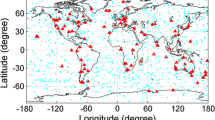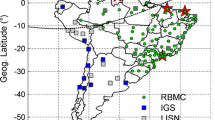Abstract
Radio occultation (RO) is a powerful technique for providing vertical profiles of refractivity, temperature, pressure, and water vapor of the neutral atmosphere and electron density of the ionosphere. The Abel inversion method which is based on the spherical symmetry assumption has been widely utilized to retrieve electron density profiles (EDPs) from RO measurements, which are available by observing Global Navigation Satellite System (GNSS) satellites from low-earth-orbit satellites. It is well known that the Abel inversion is subject to errors in the presence of ionospheric horizontal gradients. With the arrival of new navigation systems, the opportunities of establishing simultaneous GNSS RO events are increasing. We develop an improved Abel inversion technique that accounts for pairs of simultaneous RO events to relax the spherical symmetry assumption. Through the use of Tikhonov regularization, the problem is formulated so that numerical conditioning is improved and a priori information such as expected electron density, asymmetric factor, and vertical total electron content can be incorporated. Appropriate weighting can be determined to reflect the availability and quality of information. By balancing the reference data and measurements, the method thus paves a way for ionospheric probing in challenging geomagnetic conditions as both the EDP at the intersection and the horizontal gradients are retrieved. Simulation and experimental results are provided to show the effectiveness of the proposed method. The robustness and sensitivity of the proposed method are also assessed.






Similar content being viewed by others
References
Angling MJ, Cannon PS (2004) Assimilation of radio occultation measurements into background ionospheric models. Radio Sci 39:RS1S08. doi:10.1029/2002RS002819
Bilitza D, McKinnell LA, Reinisch B, Fuller-Rowell T (2011) The international reference ionosphere (IRI) today and in the future. J Geodesy. doi:10.1007/s00190-010-0427-x
Bust GS, Garner TW, Gaussiran TL II (2004) Ionospheric data assimilation three dimensional (IDA3D): a global, multisensor, electron density specification algorithm. J Geophys Res 109:A11312. doi:10.1029/2003JA010234
Fjeldbo G, Eshleman VR (1965) The bistatic radar-occultation method for the study of planetary atmospheres. J Geophys Res 70(15):3217–3225. doi:10.1029/JZ070i013p03217
Garcia-Fernandez M, Hernandez-Pajares M, Juan M, Sanz J (2003) Improvement of ionospheric electron density estimation with GPS/MET occultations using Abel inversion and VTEC information. J Geophys Res 108(A9):1338. doi:10.1029/2003JA009952
Hajj GA, Romans LJ (1998) Ionospheric electron density profiles obtained with the global positioning system: results from the GPS/MET experiment. Radio Sci 33:175–190. doi:10.1029/97RS03183
Hajj GA, Ibahez-Meier R, Kursinski ER, Romans LJ (1994) Imaging the ionosphere with the global positioning system. Int J Imag Syst Tech 5:74–184
Hernández-Pajares M, Juan M, Sanz J (2000) Improving the Abel inversion by adding ground GPS data to LEO radio occultations in ionospheric sounding. Geophys Res Lett 27:2473–2476. doi:10.1029/2000GL000032
Hernández-Pajares M, Juan JM, Sanz JM, Orus R, Garcia-Rigo A, Feltens J, Komjathy A, Schaer SC, Krankowski A (2009) The IGS VTEC maps: a reliable source of ionospheric information since 1998. J Geod 83:263–275. doi:10.1007/s00190-008-0266-1
Hocke K, Igarashi K (2002) Electron density in the F region derived from GPS/MET radio occultation data and comparison with IRI. Earth Planets Space 54:947–954. doi:10.1186/BF03352442
Hysell DL (2007) Inverting ionospheric radio occultation measurements using maximum entropy. Radio Sci 42:RS4022. doi:10.1029/2007RS003635
Juang JC, Tsai YF, Chu CH (2013) On constellation design of multi-GNSS radio occultation mission. Acta Astronaut 82(1):88–94
Kulikov I, Mannucci AJ, Pi X, Raymond C, Hajj GA (2011) Electron density retrieval from occulting GNSS signals using a gradient-aided inversion technique. Adv Space Res 47:289–295. doi:10.1016/j.asr.2010.07.002
Lei J et al (2007) Comparison of COSMIC ionospheric measurements with ground-based observations and model predictions: preliminary results. J Geophys Res 112:A07308. doi:10.1029/2006JA012240
Liou YA, Pavelyev AG, Liu SF, Pavelyev AA, Yen N, Huang CY, Fong CJ (2007) FORMOSAT-3/COSMIC GPS radio occultation mission: preliminary results. IEEE Trans Geosci Remote Sens 45(13):3813–3826. doi:10.1109/TGRS.2007.903365
Liu JY, Lin CY, Lin CH, Tsai HF, Solomon SC, Sun YY, Lee IT, Schreiner WS, Kuo YH (2010) Artificial plasma cave in the low-latitude ionosphere results from the radio occultation inversion of the FORMOSAT-3/COSMIC. J Geophys Res 115:A07319. doi:10.1029/2009JA015079
Pham VC, Juang JC (2014) Assessment of simultaneous GNSS occultation data on ionosphere probing. In: Proceedings of ION GNSS + 2014, Institute of Navigation, Tampa, Florida, pp 1508–1512
Rocken C, Kuo YH, Schreiner W, Hunt D, Sokolovskiy S, McCormick C (2000) COSMIC system description. Terr Atmos Oceanic Sci 11(1):21–52
Schreiner WS, Sokolovskiy SV, Rocken C, Hunt DC (1999) Analysis and validation of GPS/MET radio occultation data in the ionosphere. Radio Sci 34(4):949–966. doi:10.1029/1999RS900034
Schunk RW et al (2004) Global assimilation of ionospheric measurements (GAIM). Radio Sci 39:RS1S02. doi:10.1029/2002RS002794
Tikhonov AN, Goncharsky AV, Stepanov VV, Yagola AG (1995) Numerical methods for the solution of ill-posed problems. Kluwer Academic Publishers, Dordrecht
Tsai LC, Tsai WH (2004) Improvement of GPS/MET ionospheric profiling and validation using the Chung-Li ionosonde measurements and the IRI model. Terr Atmos Oceanic Sci 15:589–607
Twomey S (1963) On the numerical solution of Fredholm integral equations of the first kind by inversion of the linear system produced by quadrature. J Assoc Comput Mach 10:97–101
Wang C, Hajj G, Pi X, Rosen IG, Wilson B (2004) Development of the global assimilative ionospheric model. Radio Sci 39:RS1S06. doi:10.1029/2002RS002854
Wu X, Hu X, Gong X, Zhang X, Wang X (2009) An asymmetry correction method for ionospheric radio occultation. J Geophys Res 114:A03304. doi:10.1029/2008JA013025
Yue X, Schreiner WS, Lei J, Sokolovskiy SV, Rocken C, Hunt DC, Kuo YH (2010) Error analysis of Abel retrieved electron density profiles from radio occultation measurements. Ann Geophys 28:217–222. doi:10.5194/angeo-28-217-2010
Yue X, Schreiner WS, Lin YC, Rocken C, Kuo YH, Zhao BQ (2011) Data assimilation retrieval of electron density profiles from radio occultation measurements. J Geophys Res 116:A03317. doi:10.1029/2010JA015980
Yue X, Schreiner WS, Kuo YH (2012) A feasibility study of the radio occultation electron density retrieval aided by a global ionospheric data assimilation model. J Geophys Res 117:A08301. doi:10.1029/2011JA017446
Yue X, Schreiner WS, Kuo YH, Braun JJ, Lin YC, Wan W (2014) Observing system simulation experiment study on imaging the ionosphere by assimilating ground GNSS, LEO based radio occultation and ocean reflection, and cross link. IEEE Trans Geosci Remote Sens 52(7):3759–3773. doi:10.1109/TGRS.2013.2275753
Yunck TP, Lindal GF, Liu CH (1988) The role of GPS in precise Earth observation. In: Symposium on IEEE position, location and navigation, Orlando
Acknowledgments
This research was financially supported by National Science Council, Taiwan, under Grant NSC 101-2221-E-006-191-MY3. We acknowledge the Taiwan’s National Space Organization (NSPO) and the University Corporation for Atmospheric Research (UCAR), the National Geophysical Data Center (NGDC), and the IRI working group for providing FORMOSAT-3/COSMIC data, ionosonde data, and the IRI-2012 model, respectively. We are thankful to C. H. Lin and H.-F. Tsai from National Cheng Kung University for their helpful discussion.
Author information
Authors and Affiliations
Corresponding author
Rights and permissions
About this article
Cite this article
Pham, VC., Juang, JC. Ionosphere probing with simultaneous GNSS radio occultations. GPS Solut 21, 101–109 (2017). https://doi.org/10.1007/s10291-015-0501-1
Received:
Accepted:
Published:
Issue Date:
DOI: https://doi.org/10.1007/s10291-015-0501-1




